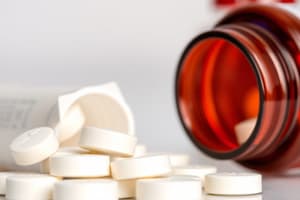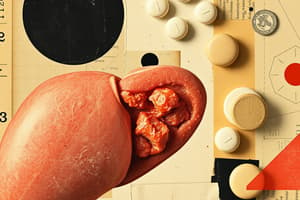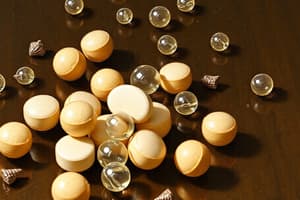Podcast
Questions and Answers
What type of drugs inhibit platelet function?
What type of drugs inhibit platelet function?
- Pain relievers
- Anti-inflammatory drugs
- NSAIDs (correct)
- Anticoagulants
What is a common side-effect of warfarin?
What is a common side-effect of warfarin?
- Nausea
- Hemorrhage (correct)
- Skin rash
- Diarrhea
Can warfarin be used in breast-feeding mothers?
Can warfarin be used in breast-feeding mothers?
- Only in low doses
- Only in emergency situations
- No
- Yes (correct)
What is a rare side-effect of warfarin?
What is a rare side-effect of warfarin?
What is the name of the oral anticoagulant mentioned in the text?
What is the name of the oral anticoagulant mentioned in the text?
Why does warfarin increase the risk of hemorrhage?
Why does warfarin increase the risk of hemorrhage?
What is a teratogenic effect of warfarin?
What is a teratogenic effect of warfarin?
When does warfarin cause skin necrosis?
When does warfarin cause skin necrosis?
What is the effect of warfarin on protein C biosynthesis?
What is the effect of warfarin on protein C biosynthesis?
What is a potential complication of thrombosis in venules?
What is a potential complication of thrombosis in venules?
What is a benefit of DOACs compared to Vitamin K antagonists?
What is a benefit of DOACs compared to Vitamin K antagonists?
What is a symptom associated with thrombosis in venules?
What is a symptom associated with thrombosis in venules?
What is a characteristic of DOACs?
What is a characteristic of DOACs?
What is a common location where thrombosis may occur?
What is a common location where thrombosis may occur?
What is a complication of thrombosis in venules?
What is a complication of thrombosis in venules?
What type of anticoagulants are DOACs?
What type of anticoagulants are DOACs?
What is a benefit of DOACs over Vitamin K antagonists?
What is a benefit of DOACs over Vitamin K antagonists?
What is a characteristic of thrombosis in venules?
What is a characteristic of thrombosis in venules?
What is a symptom associated with thrombosis?
What is a symptom associated with thrombosis?
What is warfarin primarily used to prevent?
What is warfarin primarily used to prevent?
What is monitored in patients taking warfarin?
What is monitored in patients taking warfarin?
What is the purpose of measuring the INR in patients taking warfarin?
What is the purpose of measuring the INR in patients taking warfarin?
What is the name of the ratio used to monitor warfarin's effectiveness?
What is the name of the ratio used to monitor warfarin's effectiveness?
What is a common indication for warfarin therapy?
What is a common indication for warfarin therapy?
Why is warfarin considered a narrow therapeutic index drug?
Why is warfarin considered a narrow therapeutic index drug?
What is the purpose of taking warfarin in patients with mechanical heart valves?
What is the purpose of taking warfarin in patients with mechanical heart valves?
What is the relationship between the INR and the prothrombin time?
What is the relationship between the INR and the prothrombin time?
What is the indication for warfarin therapy in patients with venous thromboembolism?
What is the indication for warfarin therapy in patients with venous thromboembolism?
What is the primary goal of warfarin therapy?
What is the primary goal of warfarin therapy?
Flashcards are hidden until you start studying
Study Notes
Lipid-Lowering Drugs
- HMG-CoA reductase inhibitors, PCSK9 MAB, niacin, ezetimibe, and resins are used to treat hyperlipidemias, such as secondary sarcoidosis.
- These drugs work by reducing cholesterol levels, leading to increased bile acid synthesis.
Pulmonary Arterial Hypertension (PAH)
- Exertional dyspnea is the most common symptom of PAH.
- Chest pain and syncope may also occur.
- Characteristic physical examination findings include loud P2 (Pulmonic closure sound) and left parasternal heave (due to right ventricular hypertrophy).
Management of PAH
- Treatment should first involve addressing any underlying conditions, such as with anticoagulants or oxygen.
- If there is a positive response to acute vasodilator testing, oral calcium channel blockers can be used.
Pathophysiology of PAH
- Three pathways are involved in the development of PAH:
- Nitric oxide pathway
- Prostacyclin pathway
- Endothelin pathway
Anticoagulants
- Warfarin is an oral anticoagulant with a long half-life, requiring several days to achieve a stable INR.
- Factors that may potentiate warfarin:
- Liver disease
- P450 enzyme inhibitors (e.g., amiodarone, ciprofloxacin)
- Cranberry juice
- Drugs that displace warfarin from plasma albumin (e.g., NSAIDs)
- Drugs that inhibit platelet function (e.g., NSAIDs)
- Side effects of warfarin:
- Hemorrhage
- Teratogenic effects (although safe for breast-feeding mothers)
- Skin necrosis (when warfarin is first started, biosynthesis of protein C is reduced)
Acute Vasodilator Testing
- Aims to determine which patients show a significant fall in pulmonary arterial pressure following vasodilator administration
- Vasodilators used: IV Epoprostenol, inhaled nitric oxide, prostacyclin analogues (iloprost, treprostinil), and phosphodiesterase-5 (PDE-5) inhibitors (sildenafil)
Blood Coagulation
Platelet Aggregation and Blood Coagulation
- Involved in antiplatelet drugs and anticoagulants
Antiplatelet Drugs
- No specific information provided
Anticoagulants
Injectable Anticoagulants
- Standard heparin: administered intravenously, short duration of action, side effects include bleeding, heparin-induced thrombocytopenia (HIT), and osteoporosis
- Low molecular weight heparin (LMWH): administered subcutaneously, long duration of action, side effects include bleeding, lower risk of HIT and osteoporosis
Monitoring
- Standard heparin: monitored using activated partial thromboplastin time (APTT)
- LMWH: monitored using anti-Factor Xa (although routine monitoring is not required)
- Heparin overdose may be reversed by protamine sulphate, although this only partially reverses the effect of LMWH
Indications
- Venous thromboembolism
- Atrial fibrillation
- Mechanical heart valves
Oral Anticoagulants
Warfarin
- Monitored using the INR (international normalised ratio)
- Has a long half-life, achieving a stable INR may take several days
- Factors that may potentiate warfarin:
- Liver disease
- P450 enzyme inhibitors (e.g. amiodarone, ciprofloxacin)
- Cranberry juice
- Drugs that displace warfarin from plasma albumin
- Thrombosis may occur in venules, leading to skin necrosis and purple toes
Direct Oral Anticoagulants (DOACs)
- Have a fixed dosing regimen and do not require frequent monitoring
- Offer greater convenience to patients compared to Vitamin K antagonists (e.g. warfarin)
Disorders of Lipid Metabolism
- Disorders of lipid metabolism can occur as primary conditions (familial or polygenic) or secondary to an underlying disease state or drug treatment.
- Risks of dyslipidemias include increased risk of atherosclerosis, ischaemic heart disease, cerebrovascular disease, and peripheral vascular diseases, directly related to increasing levels of serum cholesterol.
Management of Dyslipidemias
- Increase intake of unsaturated fats (e.g., olive oil, salmon, cashews, almonds) to help manage dyslipidemias.
- Increase physical activity to reduce risks of dyslipidemias.
Lipid-Lowering Drugs
- Statins: inhibit HMG CoA reductase, reducing cholesterol synthesis; examples include Atorvastatin, Simvastatin, and Rosuvastatin; adverse effects include muscle pain (myositis) and liver damage.
- Ezetimibe: decreases cholesterol absorption in the small intestine; adverse effects include headache.
- Nicotinic acid (Niacin, Vit B3): decreases hepatic VLDL secretion; adverse effects include myositis and flushing.
- Fibrates: agonist of PPAR-alpha, increasing lipoprotein lipase expression; examples include Gemfibrozil and Fenofibrate; adverse effects include myositis, pruritus, and cholestasis.
- Cholestyramine: binds bile acid, decreasing reabsorption in the small intestine; adverse effects include GI side-effects.
Pulmonary Arterial Hypertension (PAH)
- Defined as a sustained elevation in mean pulmonary arterial pressure (>25 mmHg at rest or >30 mmHg after exercise).
- Acute vasodilator testing: decides which patients show a significant fall in pulmonary arterial pressure following vasodilator administration (e.g., IV Epoprostenol or inhaled nitric oxide).
- Indications for PAH treatment include venous thromboembolism, atrial fibrillation, and mechanical heart valves.
Studying That Suits You
Use AI to generate personalized quizzes and flashcards to suit your learning preferences.




